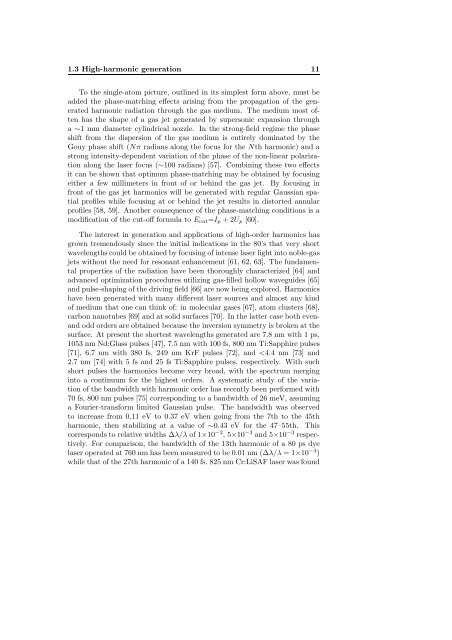VUV Spectroscopy of Atoms, Molecules and Surfaces
VUV Spectroscopy of Atoms, Molecules and Surfaces
VUV Spectroscopy of Atoms, Molecules and Surfaces
You also want an ePaper? Increase the reach of your titles
YUMPU automatically turns print PDFs into web optimized ePapers that Google loves.
1.3 High-harmonic generation 11<br />
To the single-atom picture, outlined in its simplest form above, must be<br />
added the phase-matching effects arising from the propagation <strong>of</strong> the generated<br />
harmonic radiation through the gas medium. The medium most <strong>of</strong>ten<br />
has the shape <strong>of</strong> a gas jet generated by supersonic expansion through<br />
a ∼1 mm diameter cylindrical nozzle. In the strong-field regime the phase<br />
shift from the dispersion <strong>of</strong> the gas medium is entirely dominated by the<br />
Gouy phase shift (Nπ radians along the focus for the Nth harmonic) <strong>and</strong> a<br />
strong intensity-dependent variation <strong>of</strong> the phase <strong>of</strong> the non-linear polarization<br />
along the laser focus (∼100 radians) [57]. Combining these two effects<br />
it can be shown that optimum phase-matching may be obtained by focusing<br />
either a few millimeters in front <strong>of</strong> or behind the gas jet. By focusing in<br />
front <strong>of</strong> the gas jet harmonics will be generated with regular Gaussian spatial<br />
pr<strong>of</strong>iles while focusing at or behind the jet results in distorted annular<br />
pr<strong>of</strong>iles [58, 59]. Another consequence <strong>of</strong> the phase-matching conditions is a<br />
modification <strong>of</strong> the cut-<strong>of</strong>f formula to Ecut=Ip +2Up [60].<br />
The interest in generation <strong>and</strong> applications <strong>of</strong> high-order harmonics has<br />
grown tremendously since the initial indications in the 80’s that very short<br />
wavelengths could be obtained by focusing <strong>of</strong> intense laser light into noble-gas<br />
jets without the need for resonant enhancement [61, 62, 63]. The fundamental<br />
properties <strong>of</strong> the radiation have been thoroughly characterized [64] <strong>and</strong><br />
advanced optimization procedures utilizing gas-filled hollow waveguides [65]<br />
<strong>and</strong> pulse-shaping <strong>of</strong> the driving field [66] are now being explored. Harmonics<br />
have been generated with many different laser sources <strong>and</strong> almost any kind<br />
<strong>of</strong> medium that one can think <strong>of</strong>: in molecular gases [67], atom clusters [68],<br />
carbon nanotubes [69] <strong>and</strong> at solid surfaces [70]. In the latter case both even<strong>and</strong><br />
odd orders are obtained because the inversion symmetry is broken at the<br />
surface. At present the shortest wavelengths generated are 7.8 nm with 1 ps,<br />
1053 nm Nd:Glass pulses [47], 7.5 nm with 100 fs, 800 nm Ti:Sapphire pulses<br />
[71], 6.7 nm with 380 fs, 249 nm KrF pulses [72], <strong>and</strong>















